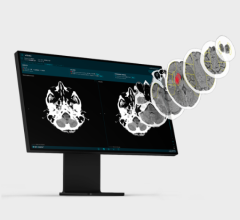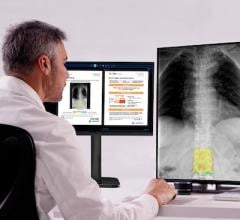Finding a Paradigm Shift in Medical Imaging at HIMSS
An example of augmented reality displays by Novarad at HIMSS 2017. The system uses a visor to project co-registered 3-D datasets on a real patient in an operating room to aid procedural navigation.
While attending this year’s Health Information and Management Systems Society (HIMSS) conference in Orlando, ITN editor Dave Fornell found two exciting new technologies that appear to have the potential to become paradigm shifts in medicine. The first is the integration of artificial intelligence into medical imaging IT systems; the second is the use of augmented reality 3-D imaging visors to create a heads-up display of 3-D imaging anatomical reconstructions, or complete computed tomography (CT) or magnetic resonance imaging (MRI) datasets surgeons can use in the operating room (OR).
HIMSS left many, including Dave, feeling energized about the prospects artificial intelligence (AI) may offer medicine. But, unlike the science fiction image that snaps into most peoples’ minds when you talk about AI, it will not be an interactive, highly intelligent robot that will replace doctors. In fact, most users will not even be aware AI is assisting them in the back end of their electronic medical record (EMR) systems. AI is a topic that has been discussed for a few years now at medical conferences, but several concrete examples of how AI will help clinicians significantly reduce time and workflow efficiency were showcased this year at HIMSS. AI will accomplish this by working in the background as an overlay software system that sits on top of the PACS, specialty reporting systems and medical image archives at a hospital.
The AI algorithms are taught through machine learning to recognize complex patterns and relations of specific types of data that are relevant to the image or disease states being reviewed.
AI is also making its appearance in business and clinical analytical software, as well as imaging modality software, where it can automatically identify all the organs and anatomy, orientate the images into the standard reading reviews and perform auto-quantification. This is already available on some systems.
You can read more about Dave’s insights at HIMSS 2017 in his Web-exclusive feature, “How Artificial Intelligence Will Change Medical Imaging,” at http://bit.ly/2mPbzwF.
You can also watch the video “Editor’s Choice of Most Innovative Technology at HIMSS 2017 at http://bit.ly/2lXBuDm, and take a tour of some of the most innovative new technology that was displayed on the expo floor at HIMSS.
For more information on enterprise imaging from HIMSS, check out “How to Build an Enterprise Imaging System” at http://bit.ly/2noruU1. Enterprise imaging system expert Louis Lannum was in charge of Cleveland Clinic’s efforts to connect images and other data from 33 of its departments into a single, centralized database that could deliver the content through a viewer in the electronic medical record. He spoke on the key requirements for enterprise imaging systems at HIMSS 2017.



 December 24, 2025
December 24, 2025 









